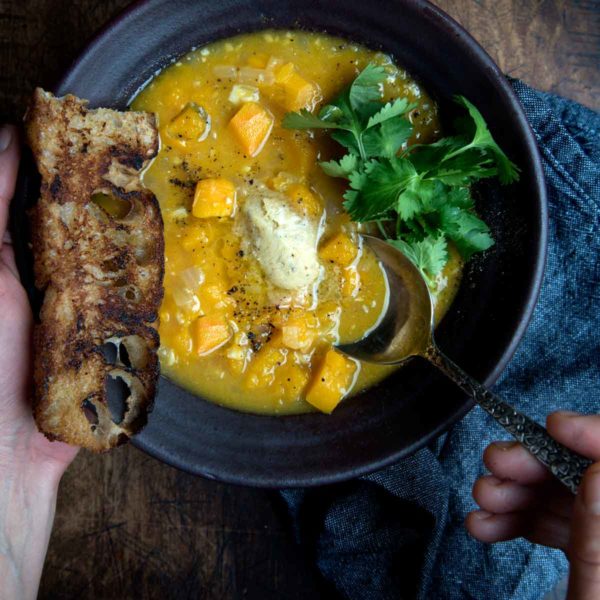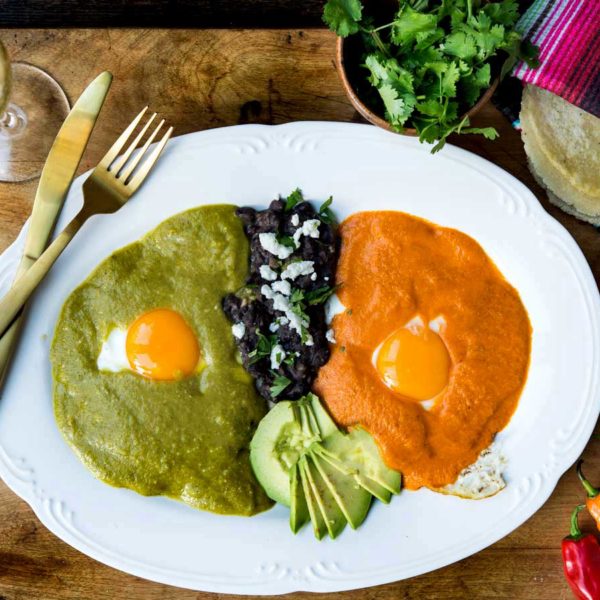Bibimbap, a Korean dish, which appropriately translates into “mixed rice.”
First, lets talk about the rice. The delectable, golden brown, crispy rice… Dolsot (meaning “stone pot”) bibimbap is a variation of this dish in which the vegetables and rice are served in a sizzling hot stone pot. The layer of rice touching the hot stone becomes golden brown and crispy, which adds a welcome texture and toastiness to the rice. I found a stone bowl at my favorite Asian grocery store for around $20 (which I purchased mostly for its aesthetics rather than function). But don’t despair if you don’t have one, as you can easily achieve the same effect by using a cast-iron skillet. Just spread out the steamed rice in a well seasoned skillet, and let cook undisturbed, rotating from time to time, until the bottom layer of rice is golden brown and crispy (reminiscent of the crust that forms on the bottom layer of the pan when cooking paella — the soccarat).
The chile paste and flakes warrant further explanation…First, the chile paste. Gochujang is not your ordinary chile paste. It’s a condiment comprised of chile peppers, glutinous rice, soybeans, and salt, left to ferment in the sun in large earthenware pots. If you are feeling adventurous you can make your own homemade gochujang. If not, you can find gochujang at a Korean grocery store; a plethora of brands line the shelves (at least here). My general rule of thumb, go for the one that has the least amount of ingredients.
Next, gochugaru (Korean chile flakes). Gochugaru is made from sun-dried chile peppers, which are then crushed into flakes or finely ground. Gochugaru is sweet, spicy, and a slightly smoky. Maewoon gochu gaaroo is very spicy. Deol Maewoon gochu gaaroo is less spicy. I’ve seen recipes that call for crushed red pepper flakes or cayenne in lieu of gochugaru, but these are not suitable substitutes. Gochugaru is worth tracking down.
Lastly, the toppings, the endless array of toppings. This is where you can have some fun — any number of seasonal vegetables, assorted mushrooms, marinated meat (bulgogi), tofu, seaweed, egg (raw, poached, or sunny side up); change them up depending on your mood.
Today, carrots, mung bean sprouts, dried (chanterelle) mushrooms, daikon/watermelon radish, scallions, wakame seaweed, baby spinach/Swiss chard, nori strips, kimchi, crispy tofu, toasted sesame seeds, and gochujang/date sauce — topped with a fried egg. Whew, that was a mouthful. I tend to go a bit overboard some times. These are just a few suggestions, add some, add all, or substitute with your favorite seasonal vegetables.
Now that I’ve gone through the explanation of all the ingredients, the only thing left to do is to dig in.
Serve with a side of kimchi and be sure to have plenty of gochujang on hand…
Bibimbap
Adapted from Bon Appetit
serves 8
Crispy Rice
1 tablespoon toasted sesame oil
8 cups steamed short grain white or brown rice (from 2 1/2 cups dry rice)
Heat 1 tablespoon oil in a large cast-iron or nonstick skillet over medium heat. Add rice; pat out in an even layer. Cook, rotating skillet for even browning (do not stir), until rice is golden and crisp on bottom, about 15 minutes.
Divide rice among bowls. Top with beef, Bibimbap Mix-Ins, and eggs. Serve kimchi alongside with plenty of Gochujang or Gochujang-Date Sauce.
Bibimbap Mix-Ins Suggestions:
Bulgogi
Adapted from Chef Bill Kim and Maangchi
makes 2 cups
1/2 cup reduced-sodium soy sauce
1/2 Asian pear
1/2 small onion
1 scallion, thinly sliced
4 garlic cloves, minced
11/2 to 2 tablespoons brown sugar (depending on desired level of sweetness)
2 tablespoons grated peeled ginger
1 tablespoon toasted sesame oil
freshly cracked black pepper to taste
1 pound thinly sliced (1/8-inch) skirt steak, boneless beef rib-eye steak, or short ribs
Oil for pan frying
In a blender, puree all ingredients (except for the beef) until smooth. Add the beef; toss to coat. Cover and chill for 30 minutes or up to 3 hours. Heat 1/2 tablespoon oil in a large heavy skillet over medium heat. Add one-quarter of the beef and cook, turning once, until cooked through and lightly browned, about 3 minutes. Transfer to a bowl. Repeat in three batches with the remaining oil and beef.
Note: Can make the marinade and refrigerate up to 3 days in advance.
Sesame-Pepper Bean Sprouts
Mix 2 tablespoons toasted sesame seeds, 1/2 teaspoon sea salt, and 1/4 teaspoon freshly ground black pepper in a small bowl; set aside. Cook 6 cups mung bean sprouts (about 12 ounces) in a large pot of boiling salted water until soft but not mushy, 2-3 minutes. Drain well. Transfer to a medium bowl. Add 2 teaspoons toasted sesame oil; toss to coat. Season with sesame mixture and gochugaru (coarse Korean red pepper powder). Serve remaining sesame mixture with Bibimbap.
Sesame Carrots
Peel and cut 4 medium carrots into long matchstick-size pieces. Heat 1 tablespoon toasted sesame oil in a large skillet, preferably nonstick, over medium heat. Add carrots and cook, stirring occasionally, until just tender, 3-4 minutes. Season with salt and freshly ground black pepper.
Sesame Radish (such as daikon, watermelon)
Peel and cut 4 medium radish into long matchstick-size pieces. Heat 1 tablespoon toasted sesame oil in a large skillet, preferably nonstick, over medium heat. Add radish and cook, stirring occasionally, until just tender, 3-4 minutes. Season with salt and freshly ground black pepper.
Garlicky Spinach/Swiss Chard
Cook two (10-ounce) bags fresh spinach and/or Swiss Chard in a large pot of boiling salted water just until wilted, 1-2 minutes. Drain, then transfer to a bowl of ice water; let cool. Drain and squeeze out excess water.
Heat 2 tablespoons toasted sesame oil in a large nonstick skillet over medium heat. Add 2 chopped garlic cloves and cook, stirring, until fragrant, 1 minute. Add spinach, 2 tablespoons reduced-sodium soy sauce, and 1 teaspoon rice wine vinegar. Stir to combine; season with salt and freshly ground black pepper.
Soy-Glazed Dried Mushrooms (such as shiitakes, chanterelles)
Bring 3 cups dried mushrooms (about 3 ounces), 1/3cup reduced-sodium soy sauce, 3/4 teaspoon honey or agave, and 1 cup water to a boil in a small saucepan. Cover, reduce heat to medium-low. Simmer, stirring occasionally, until mushrooms are softened and all liquid is absorbed, 12-15 minutes. Let mushrooms cool slightly, then thinly slice. Transfer to a small bowl, add 1/2 teaspoon toasted sesame seeds, and season with freshly ground black pepper.
Scallion Slaw
Cut 2 bunches scallions into 3-inch lengths, then thinly slice lengthwise. Place in a bowl of ice water (to crisp). Just before serving, drain well, pat dry, and transfer to another bowl. Add 1 tablespoon rice wine vinegar and 1 tablespoon toasted sesame oil; toss to coat. Season with salt, freshly ground black pepper, and gochugaru (coarse Korean red pepper powder).
Crispy Tofu
Drain the tofu and cut into ~1/2 inch slices. Bring some well-salted water to a boil and pour it over the tofu. Let it stand for about 15 minutes, then drain (this step is optional but recommended). Pat the tofu dry, removing as much moisture as possible (less moisture allows it to brown better). Heat 2 tablespoons of oil to a large skillet. When hot, place the tofu in the skillet in a single layer. Cook on the first side until nice and golden brown, about 3-4 minutes, flip and repeat on the other side.
Wakame
Place 1 ounce wakame (dried seaweed) in a medium bowl; cover with cold water and let sit until softened, about 5 minutes. Drain seaweed, squeeze out excess water, and coarsely chop.
Gochujang-Date Sauce
Place five pitted Medjool dates in a small bowl; cover with boiling water and let sit until softened, about 10 minutes. Drain. Transfer dates to a food processor. Add 1 cup gochujang (Korean hot pepper paste) and 2 tablespoons toasted sesame oil. Purèe until smooth.
Fried eggs (or poached or raw)
Place on top of each bowl.










